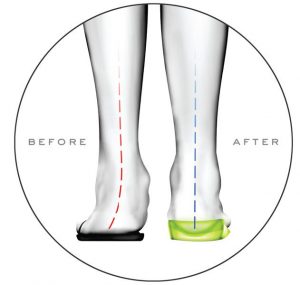Custom Orthotics
Custom orthotics are specially-made shoe inserts that are designed to support and comfort your feet.
Striving To Cover All Your Foot & Ankle Needs
Foot pain isn’t normal. Orthotics will help you if:
- One side of the sole of your shoe wears out faster than the other.
- You frequently sprain your ankle.
- You have chronic heel, knee, or lower back pain.
- Your toes are not straight.
- Your feet point inward or excessively outward when you walk.
What Are Prescription Custom Orthotics?
Custom orthotics are specially-made devices designed to support and comfort your feet. Prescription orthotics are crafted for you and no one else. They match the contours of your feet precisely and are designed for the way you move. Orthotics are only manufactured after a podiatrist has conducted a complete evaluation of your feet, ankles, and legs, so the orthotic can accommodate your unique foot structure and pathology.
Prescription orthotics are divided into two categories:
- Functional orthotics are designed to control abnormal motion. They may be used to treat foot pain caused by abnormal motion; they can also be used to treat injuries such as shin splints or tendinitis. Functional orthotics are usually crafted of a semi-rigid material such as plastic or graphite.
- Accommodative orthotics are softer and meant to provide additional cushioning and support. They can be used to treat diabetic foot ulcers, painful calluses on the bottom of the foot, and other uncomfortable conditions.
 Dr. Farajian uses orthotics to treat foot problems such as plantar fasciitis, bursitis, tendinitis, diabetic foot ulcers, and foot, ankle, and heel pain. Clinical research studies have shown that podiatrist-prescribed foot orthotics decrease foot pain and improve function.
Dr. Farajian uses orthotics to treat foot problems such as plantar fasciitis, bursitis, tendinitis, diabetic foot ulcers, and foot, ankle, and heel pain. Clinical research studies have shown that podiatrist-prescribed foot orthotics decrease foot pain and improve function.
Children are sometimes given orthoses to treat flatfoot or intoeing or outtoeing disorders. Athletes often are given orthoses to mitigate pain while they train and compete.
Orthotics typically cost more than shoe inserts purchased in a retail store, but the additional cost is usually well worth it. Unlike shoe inserts, orthotics are molded to fit each individual foot, so you can be sure that your orthotics fit and do what they’re supposed to do. Prescription orthotics are also made of top-notch materials and last many years when cared for properly. Insurance often helps pay for prescription orthotics.
What are Shoe Inserts?
You’ve seen them at the grocery store and at the mall. You’ve probably even seen them on TV and online. Shoe inserts are any kind of non-prescription foot support designed to be worn inside a shoe. Pre-packaged arch supports are shoe inserts. So are the “custom-made” insoles and foot supports that you can order online or at retail stores. Unless the device has been prescribed by a doctor and crafted for your specific foot, it’s a shoe insert, not a custom orthotic device—despite what the ads might say.
Shoe inserts can be very helpful for a variety of foot ailments, including flat arches and foot and leg pain. They can cushion your feet, provide comfort, and support your arches, but they can’t correct biomechanical foot problems or cure long-standing foot issues.
When to Visit a Podiatrist
If you have pain or discomfort, schedule an appointment with Family Foot & Ankle. Dr. Farajian will assess your overall health and look for any other contributing factors. As a podiatrist she is specially trained to evaluate the biomechanics of the lower extremity, and will examine your feet and how you walk.
A cast is created to capture the shape of your foot exactly, and is sent to the lab in order to create a perfect orthotic insert for your shoes to improve your foot movement and lead to more comfort and mobility.
How do orthotic devices work?
Orthotics make standing, walking, and running more comfortable and efficient by altering the angles at which the foot strikes the ground. Orthotics placed inside your shoes can absorb shock, improve balance, and take pressure off sore spots. Doctors of podiatric medicine pioneered and are developing more high-tech orthotics.
Can orthotics take the place of foot surgery?
Dr. Farajian often recommends orthotics and other conservative care for many foot and ankle problems before considering podiatric surgery.
What about people with diabetes?
For people with diabetes, arthritis, or other conditions, orthotics that do not fit properly can be dangerous. People with diabetes especially need proper diagnoses and prescriptions from a podiatrist.
